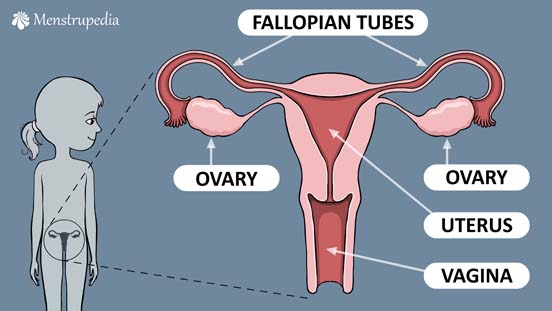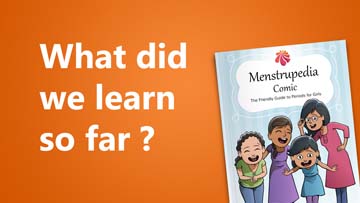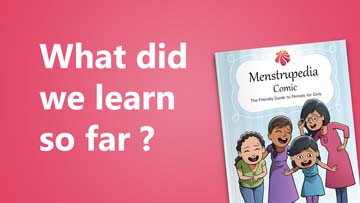Trainer's Guide: How to conduct a menstrual awareness workshop
Hello Periods
"Hello Periods" is an educational video that you can use to conduct a menstrual awareness workshop. It is important that the kids have access to Menstrupedia comic during and after the workshop so that they can get their questions answered and understand each topic in detail at their own pace.
Instruction Video
In this video Aditi Gupta shares how we at Menstrupedia use ‘Hello Periods’ to conduct menstrual awareness workshops and how you can conduct such workshops too, using the free resources available on this page.
Reference Image
This is a reference image of female reproductive system that you would need while conducting a menstrual awareness workshop.

Questions and Answers
The content of the HELLO PERIODS video has been divided into five sections. These are the questions and answers for each section.
At the end of each section you will see a pause screen in different colors as seen below. Whenever you come across such screens, please pause the video and make sure that the audience in the workshop knows the answers to the questions corresponding to that pause screen.
-
GREEN PAUSE SCREEN at 3 min 13 sec
 Q1: What changes do we see in the body while growing up?Ans: Height and weight increases, breasts begin to develop, hips widen and hair begins to appear in the underarms and around the genitals.Q2: What is vaginal discharge? Is it normal?Ans: Vaginal discharge is whitish or clear secretions from the vagina. It is normal.Q3: How many openings are there between our legs? What is the purpose of each opening?Ans: There are three openings between our legs. Urethra, from where the urine comes out, vagina, from where the baby comes out during child birth and anus, fromwhere the feces come out.
Q1: What changes do we see in the body while growing up?Ans: Height and weight increases, breasts begin to develop, hips widen and hair begins to appear in the underarms and around the genitals.Q2: What is vaginal discharge? Is it normal?Ans: Vaginal discharge is whitish or clear secretions from the vagina. It is normal.Q3: How many openings are there between our legs? What is the purpose of each opening?Ans: There are three openings between our legs. Urethra, from where the urine comes out, vagina, from where the baby comes out during child birth and anus, fromwhere the feces come out. -
ORANGE PAUSE SCREEN at 4 min 49 sec
 Q1: What do we need iron for?Ans: Iron is necessary for carrying oxygen in the blood. Deficiency of iron causes Anemia in which case you feel very weak even after taking rest.Q2: What are the sources of iron?Ans: Peas, spinach, potato with skin, dal, nuts and dry fruits and fishQ3: Why is it better to have iron rich food with food rich in vitamin C?Ans: Having iron rich food with food rich in Vitamin C increases the absorption of iron in the body.
Q1: What do we need iron for?Ans: Iron is necessary for carrying oxygen in the blood. Deficiency of iron causes Anemia in which case you feel very weak even after taking rest.Q2: What are the sources of iron?Ans: Peas, spinach, potato with skin, dal, nuts and dry fruits and fishQ3: Why is it better to have iron rich food with food rich in vitamin C?Ans: Having iron rich food with food rich in Vitamin C increases the absorption of iron in the body.VIOLET PAUSE SCREEN at 7 min 51 sec
 Q1: What are periods? Is it normal?Ans: Periods is a process in which blood comes out of the vagina for 3-7 days. It is normal.Q2: Why does blood come out of vagina during periods?Ans: In the absence of a baby, the uterus sheds its inner lining of blood and soft tissue, which we see as blood coming out of the vagina.Q3: When do periods start and stop?Ans: Periods generally start between the ages of 10 to 15 years and stop between the ages of 45 to 55 years.
Q1: What are periods? Is it normal?Ans: Periods is a process in which blood comes out of the vagina for 3-7 days. It is normal.Q2: Why does blood come out of vagina during periods?Ans: In the absence of a baby, the uterus sheds its inner lining of blood and soft tissue, which we see as blood coming out of the vagina.Q3: When do periods start and stop?Ans: Periods generally start between the ages of 10 to 15 years and stop between the ages of 45 to 55 years.RED PAUSE SCREEN at 11 min 36 sec
 Q1: Can you find out when will you get your next period? How?Ans: Yes. Periods generally occur after regular intervals which can be known by tracking periods on a calendar. This interval is known as length of menstrual cycle. By knowing the date of last period and the length of menstrual cycle, we can find out the date of next period.Q2: Why do some girls feel pain in their lower abdomen during periods? How to reduce pain?Ans: The uterus contracts to squeeze out the menstrual fluid. That’s why some girls feel pain in their lower abdomen. The pain can be reduced by applying a warm heating pad to the lower abdomen and getting the body into child pose (Balasana), butterfly pose (Titliasana) and cobra pose (Bhujangasana) and holding the pose for five deep breaths.Q3: What is menopause?Ans: Between the ages of 45 and 55 years, periods stop. This is known as menopause.
Q1: Can you find out when will you get your next period? How?Ans: Yes. Periods generally occur after regular intervals which can be known by tracking periods on a calendar. This interval is known as length of menstrual cycle. By knowing the date of last period and the length of menstrual cycle, we can find out the date of next period.Q2: Why do some girls feel pain in their lower abdomen during periods? How to reduce pain?Ans: The uterus contracts to squeeze out the menstrual fluid. That’s why some girls feel pain in their lower abdomen. The pain can be reduced by applying a warm heating pad to the lower abdomen and getting the body into child pose (Balasana), butterfly pose (Titliasana) and cobra pose (Bhujangasana) and holding the pose for five deep breaths.Q3: What is menopause?Ans: Between the ages of 45 and 55 years, periods stop. This is known as menopause.BLUE PAUSE SCREEN at 17 min 7 sec
 Q1: What is a sanitary pad and how to use it?Ans: Sanitary pad is a thin pad of absorbent material that is used to absorb the blood coming out during periods. Sanitary pad is worn in the underwear such that it exactly covers the opening of the vagina.Q2: How to dispose a sanitary pad? Can sanitary pad be flushed down the toilet?Ans: Used sanitary pad must be wrapped in a waste paper and put in a garbage bin. Thereafter the lid of the garbage bin must be closed. Sanitary pad should never be flushed down a toilet.Q3: What to do if you get periods in school?Ans: We should tell a teacher or school nurse about it and ask her for a pad. We can also borrow a pad from a friend.Q4: What hygiene measures should be taken during periods?Ans: We should take a shower at least once a day. We should wear clean undergarments and change them regularly. Pads should be changed regularly and hands should be washed clean before and after changing pads. Genital area should be kept clean and dry.
Q1: What is a sanitary pad and how to use it?Ans: Sanitary pad is a thin pad of absorbent material that is used to absorb the blood coming out during periods. Sanitary pad is worn in the underwear such that it exactly covers the opening of the vagina.Q2: How to dispose a sanitary pad? Can sanitary pad be flushed down the toilet?Ans: Used sanitary pad must be wrapped in a waste paper and put in a garbage bin. Thereafter the lid of the garbage bin must be closed. Sanitary pad should never be flushed down a toilet.Q3: What to do if you get periods in school?Ans: We should tell a teacher or school nurse about it and ask her for a pad. We can also borrow a pad from a friend.Q4: What hygiene measures should be taken during periods?Ans: We should take a shower at least once a day. We should wear clean undergarments and change them regularly. Pads should be changed regularly and hands should be washed clean before and after changing pads. Genital area should be kept clean and dry.Impact Assessment
If you want to assess the impact of your workshop and convert it into tangible data, you can use this module. This module consists of a pre-test and a post-test to find out the gain in menstrual awareness among the participants after the workshop.
How to use:
- There are the following two folders in the zip file:
- a. Trainer’s version
- b. Attendee’s version
- Each folder contains a pre-test and a post-test questionnaire in a word file. As the name suggests, pre-test is conducted before the workshop and post-test is conducted after the workshop.
- The questions in the Trainer’s folder have been categorized and labelled under different sections to indicate to the trainer the purpose of each of those questions.
- For the purpose of conducting test, the files in the Attendee’s version folder must be printed and used.
- Pre-tests must be as short as possible to ensure that the attendees retain their enthusiasm till the end of the test and are eager to participate in the workshop. That is why you’ll notice that the pre-test consists of only five short questions. Post-test on the other hand is more detailed and consists of 11 short questions.
- At the end of each test, for each participant, grant her 5 marks for each correct answer and 0 for each wrong answer. For questions where multiple correct answers must be ticked, grant the participant less than 5 marks if she ticks only a few correct answers but not all.
- After granting the marks, calculate the percentage: Percentage = (Total marks of the participant x 100) / Total marks in the questionnaire.
- Improvement in percentage in post-test for each girl is the improvement due to the workshop.

 Download the instruction video (226 MB)
Download the instruction video (226 MB)

